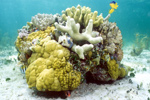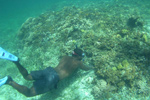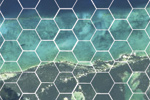

Queen conch (Strombus gigas)
photo: K. Holmes
The queen conch, a large snail (gastropod mollusk) in the Strombidae family, is found throughout and beyond the greater Caribbean, including as far north as Bermuda and as far south as Venezuela and Brazil (FAO 1977). The conch fishery is one of the most important in the region, though the species' biology makes it rather susceptible to overfishing, and it has declined throughout its range in recent decades. Trade in queen conch is now restricted following regulations of the Convention on International Trade of Endangered Species of Wild Fauna and Flora (CITES), where S. gigas is listed on Appendix II (CITES undated, Acosta 2006). The species is also listed in Annex III of the Protocol Concerning Specially Protected Areas and Wildlife to the Convention for the Protection and Development of the Marine Environment of the Wider Caribbean Region (SPAW, UNEP undated).
Economically, the conch fishery in the Caribbean is worth millions of U.S. dollars each year. Although harvest dates to prehistoric times, high levels of commercial take are relatively recent. The meat can be prepared in a variety of ways (e.g., raw ceviche-type salad, stews and chowder, or cooked in innumerable customary ways), while shells are used to make jewelry, and as a local construction material. Fishing methods include capture by hand, use of simple gear such as forked poles, or SCUBA, which is generally illegal (Catarci 2004). These methods do not greatly negatively affect habitats or ecosystems, or other species through incidental by-catch (Cascorbi 2004). In some areas, like The Bahamas, conch is harvested during the lobster fishery closed season, or as part of a multiple species effort (Catarci 2004). Management is coordinated regionally by the International Queen Conch Initiative. The fishery is regulated through temporal or spatial closures, as well as by level of maturity, size limits, gear restrictions, and catch quotas. Conch fishing in Florida - both commercial and recreational - has been prohibited since 1985, though stocks have not recovered subsequently. In 1991, the state recognized S. gigas as a "protected species" (Schlesinger 2006). In many nations, fisheries management measures are not effective due to factors such as illegal fishing and inadequate enforcement (Cascorbi 2004, Acosta 2006).
Aspects of this species' biology contribute to its vulnerability to overharvest (Gascoigne 2002, Gascoigne and Lipcius 2004, Cascorbi 2004). Queen conchs are relatively long-lived, slow growing, have delayed sexual reproduction, with a reproductive output that increases with age (CHC CIC 2003). S. gigas live up to about 25 years, mature at around 3-4 years, and are highly fecund. Reproduction occurs through internal fertilization, when large numbers of conch migrate to shallow waters for breeding. Females lay individual masses containing ~300,000 fertilized eggs. After about 5 days, larvae called veligers hatch from these egg masses and start a 3-4 week period in the plankton before settling onto shallow sand and algae, where they metamorphose into tiny snails. The conch's life history is characterized by high mortality at younger ages, however older individuals are naturally protected from predators by their strong shells. This species is, however, relatively easy for humans to capture. It lives in accessible shallow waters, is clearly visible, and moves slowly. S. gigas occur mainly in shallow sea grass beds linked to coral reefs, with the youngest being found closest to shore. Queen conch forage on plankton as larvae, and algae, sea grass, and other plants as adults (Ray and Stoner 1995, CHN CIC 2003). Vulnerability increases when conch aggregate in large numbers to spawn. This anthropogenic mortality of the later life stages, combined with habitat loss and pollution, are likely to be driving population declines. Further, reproduction in S. gigas may fail below certain density thresholds, inhibiting recovery (Stoner and Ray-Culp 2000, Gascoigne and Lipcius 2004).
Acosta, Charles A. 2006. Impending trade suspensions of Caribbean queen conch under CITES: a case study on fishery impacts and potential for stock recovery. Fisheries 31(12): 601-606.
Cascorbi, A. 2004. Seafood Watch Seafood Report: Queen Conch Strombus gigas. Available from http://www.mbayaq.org/cr/cr_seafoodwatch/content/
media/MBA_SeafoodWatch_QueenConchReport.pdf
Catarci, C. 2004. World markets and industry of selected commercially-exploited aquatic species with an international conservation profile. FAO Fisheries Circulars. Available from http://www.fao.org
CHN CIC. 2003. The geography, habitat and biology of the queen conch. Conch Heritage Network "Conch in the Classroom", curriculum resources for teachers. Available from http://www.savetheconch.org/classroom.html
CITES. Undated. Convention on International Trade in Endangered Species of Wild Fauna and Flora. Available from http://www.cites.org/eng/disc/species.shtml
FAO. 1977. Strombus gigas, Linnaeus 1758 in Species Identification Sheets for Fishery Purposes. Western Central Atlantic (fishing area 31). Gastropods. Vol. 6, Rome, FAO. Available from http://www.strombusgigas.com/strombuspercent20speciespercent20idpercent20pg1.pdf
Gascoigne, J. 2002. Grouper and conch in The Bahamas: extinction or management? The choice is now. MacAlister Elliot & Partners, Limited; B.R.E.E.F. The Bahamas Reef Environment Educational Foundation. Available from http://www.macalister-elliott.com/reports/1651R03A.pdf
Gascoigne, J., and R.N. Lipcius. 2004. Conserving populations at low abundance: delayed functional maturity and Allee effects in reproductive behaviour of the queen conch Strombus gigas, Marine Ecology Progress Series 284: 185-194.
Ray, M. and A.W. Stoner. 1995. Growth, survivorship and habitat choice in a newly settled gastropod, Strombus gigas. Marine Ecology Progress Series 123: 83-94.
Schlesinger, L. 2006 (last update). Marine Fisheries Approved Rules Summary, Florida Fish and Wildlife Conservation Commission. http://myfwc.com/marine/history/index.html
Stoner, A.W. and M. Ray-Culp. 2000. Evidence for Allee effects in an over-harvested marine gastropod: density-dependent mating and egg production. Marine Ecology Progress Series 202: 297-302.
UNEP. Undated. The SPAW Programme Specially Protected Areas and Wildlife in the Wider Caribbean Region. Available from http://www.cep.unep.org/programmes/spaw/spaw.html






